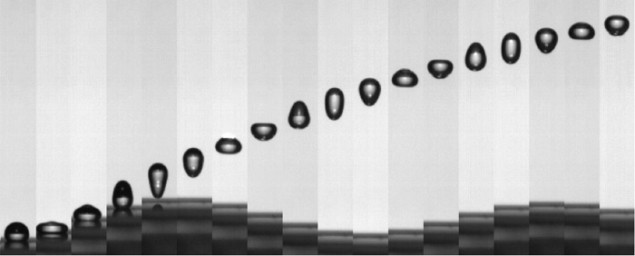
Liquid droplets or soft solid objects can be catapulted with more than twice the energy of rigid projectiles, according to physicists in France. They say that this “super propulsion” relies on additional momentum provided by the stretching and compression of deformation and could have practical applications in areas ranging from ballistics to bioengineering.
The effect involves superhydrophobic surfaces, which, like lotus leaves, are very hard to wet. Previously, scientists had shown that liquid droplets can bounce off these surfaces just like elastic balls, and now Franck Celestini of the University of Côte d’Azur in Nice and colleagues have demonstrated that these surfaces can be used to make very effective catapults.
The catapult in their case was a tiny upright spring with one end anchored to the ground and the other supporting a metal plate. Initially compressed and held at rest by an electromagnet, the spring undergoes harmonic motion when released – rising and falling over a distance of just a few millimetres but with an acceleration up to 10 times that of Earth’s gravity.
Up, up and away
Had the researchers simply placed small rigid objects on the plate, the outcome would have been straightforward. Each object would be pushed upwards until the plate reaches its maximum velocity and then starts decelerating, which occurs halfway through the spring’s expansion. At that point, the object – continuing to move upwards with the plate’s peak velocity – would be ejected by the catapult.
Instead the team covered the plate with a superhydrophobic polymer and then placed droplets of water on top of that. In this case the upward acceleration of the plate spreads the drop outwards, compressing it in the vertical direction. This slows down its centre of mass compared with the plate – so tending to delay the drop’s moment of ejection.
However, the horizontal spreading does not go on indefinitely. At a certain point, surface tension causes the drop to reassume its normal spherical shape, before overshooting and then expanding along the vertical axis. This vertical expansion gives the drop additional vertical velocity, which means that when it does fly off the plate its speed is greater than it would otherwise be.
Quick oscillation
Celestini and colleagues did their experiment using a range of spring stiffnesses and drop sizes, which varied the frequency of both the catapult’s up and down motion and the drops’ compression and expansion. As they report in Physical Review Letters, they found that drops got the biggest boost when oscillating about three times as fast as the spring did – the ejection speed and kinetic energy being, respectively, about 1.5 and 2.5 times greater than those of a rigid object.
Repeating the exercise but replacing the droplets with elastic balls made from a water-absorbing polymer, the researchers obtained essentially the same result: a kinetic-energy gain of some 250% at a frequency ratio of around 3. As such, they say that they “clearly demonstrate the generality of the phenomenon”, adding that it differs from classical resonant phenomena in that driven harmonic and parametric oscillators exhibit frequency ratios of 1 and 2, respectively. They suggest the effect be viewed as a “one-shot resonance”.
The group found it could model the projectiles’ deformation using a simple wave equation based on Hooke’s law. Although unable to derive the optimum frequency ratio analytically, the researchers did do so numerically by assuming three basic boundary conditions and then calculating the ejection time and kinetic-energy boost for a variety of ratios. This procedure yielded a value – 3.4 – close to that obtained experimentally.
Significant contribution
That value, explains Celestini, allows a projectile to be propelled upwards with a significant contribution from both the catapult and the object’s centre of mass. If the frequency ratio is too small then the object only starts to push itself up once the plate has reached maximum height (and, with it, zero velocity). But if the ratio is too high – in other words, the object is close to being rigid – then the object’s own oscillations become insignificant.
Jonathan Boreyko of Virginia Tech in the US praises the French group for its “exciting discovery”, arguing that the find could lead to a number of practical applications. Among those, he suggests, are being able to sort drops by size or elasticity – given the specific spring oscillation frequency that would boost their speed in each case. Another possibility, he says, would be transporting droplets in three-dimensional lab-on-a-chip systems.
Celestini also believes the work could have military applications. He reckons that the results might lead to “a new efficient catapult for launching aircraft”, but says he cannot provide details on such a system for the moment.



